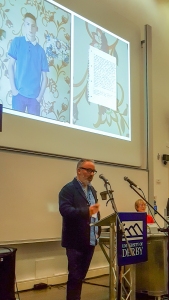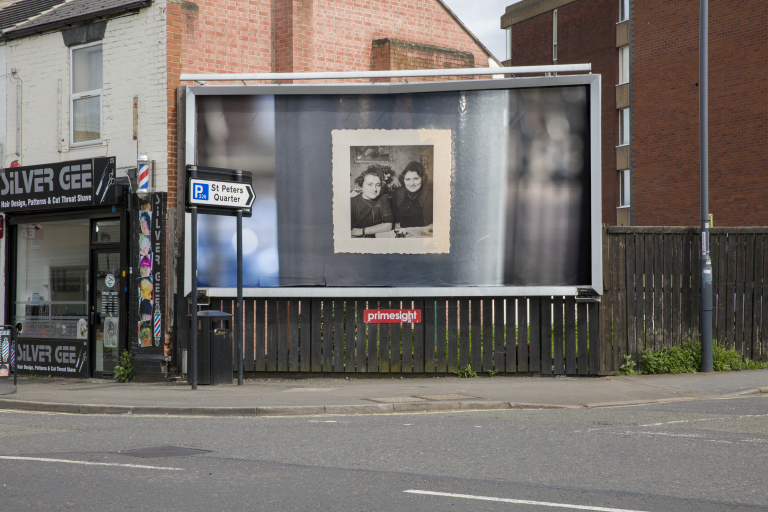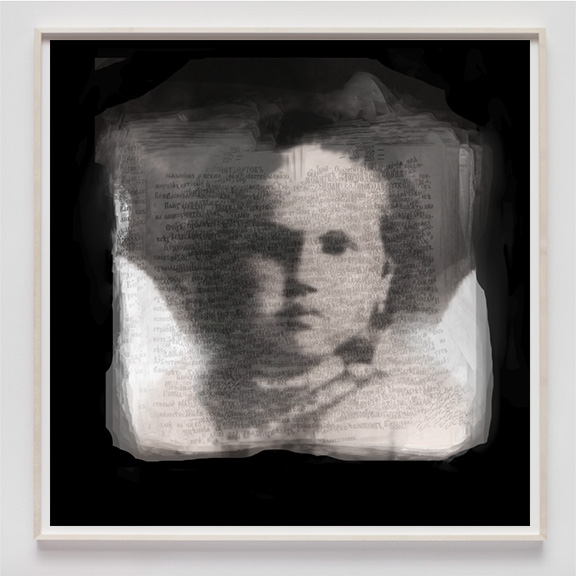Reflections on Day 2 here and Day 3, crit session here
Three days in Derby – where to start? I suppose the best place is the beginning is best but before I do, I have realised something quite important as I write this post. As with my last, it has taken me a couple of weeks to put pen to paper figuratively speaking and I realise that this time has allowed the dust to settle and the meaningful (to me) exhibitions to come to mind, So rather than regurgitate the whole weekend, I will concentrate on those.
The conference on day one was full on; too full on really with little or no time to move from one session to the next, long queues for lunch and refreshments and some speakers overrunning their slots. It was also something of a mixed bag in terms of speakers, who had according to one, been told to read from their scripts – why? Those who did had heads down sounded flat and did not interact with their audience whilst those who abandoned their scripts and spoke from the heart were much more engaging. To be fair, most were photographers rather than seasoned public speakers but still, they were speaking about their passion…
The programme for the conference consisted of a couple of introductory speeches, then into break out rooms which were loosely organised on a theme, back to the main room before and after lunch, break outs again, then a keynote speech before the festival was declared open after which there were refreshments and our first real chance to look round the exhibitions in the university building.
Two speakers from the main lecture theatre stay with me;  Craig Easton, who started off by telling us that as a Scot living in England, he was devastated not to have had a vote in the 2014 independence referendum. He had my full attention then as I had felt exactly the same! He went on to talk about the fact that this was the first time that 16 year olds had been given the vote, something I personally think should have happened with the Brexit vote but that’s another story. Anyway, this prompted Craig to talk to and photograph young people who would celebrate their 16th birthday on the day of the referendum, 18th September 2014, and project 16 which ended up being a nationwide collaborative project involving 16 photographers, including Simon Roberts and Sophie Gerrard, whose work I discussed in my last post, was born. Each of the photographers involved in the project chose a different angle, Sophie Gerrard, for example chose the places where young people spend their time, bedrooms, parks etc, whilst Simon Roberts chose faith as his theme. My one regret from this weekend is that I didn’t get to see the ‘Tethered in Time’ exhibition which was in the Old Market Hall in the centre of town. I had, in theory, time on the Sunday afternoon before I caught my train, but walked around the block in which the market hall is housed, several times and could not find a way in. The market hall is not normally open on a Sunday but it was supposed to be for this exhibition but in the end had to abandon the idea and go for my train.
Craig Easton, who started off by telling us that as a Scot living in England, he was devastated not to have had a vote in the 2014 independence referendum. He had my full attention then as I had felt exactly the same! He went on to talk about the fact that this was the first time that 16 year olds had been given the vote, something I personally think should have happened with the Brexit vote but that’s another story. Anyway, this prompted Craig to talk to and photograph young people who would celebrate their 16th birthday on the day of the referendum, 18th September 2014, and project 16 which ended up being a nationwide collaborative project involving 16 photographers, including Simon Roberts and Sophie Gerrard, whose work I discussed in my last post, was born. Each of the photographers involved in the project chose a different angle, Sophie Gerrard, for example chose the places where young people spend their time, bedrooms, parks etc, whilst Simon Roberts chose faith as his theme. My one regret from this weekend is that I didn’t get to see the ‘Tethered in Time’ exhibition which was in the Old Market Hall in the centre of town. I had, in theory, time on the Sunday afternoon before I caught my train, but walked around the block in which the market hall is housed, several times and could not find a way in. The market hall is not normally open on a Sunday but it was supposed to be for this exhibition but in the end had to abandon the idea and go for my train.
The other really good speaker in the main hall was Martin Barnes, Senior Curator of Photography at the V&A who talked about the life and work of Maurice Bloomfield, a local Derby man who started his working life in a local factory and went on to photograph British industry from the end of the war, right up to the 1980s. He apparently loved to photograph people at work, focusing on the people, for whom he had the greatest respect, rather than the process.
Often going back into the factories once they had closed so that he could light and compose his subject as he wished and also eliminate any distractions, his photographs are rich and sumptuous, works of art rather than documentary as they are described. We were able to see the Maurice Bloomfield exhibition at the Museum and Art Gallery on the Saturday and it was certainly worth seeing, though for me Bloomfield’s photographs are very obviously stage-managed and quite static, which belies the hustle and bustle of industry. Also in the Museum and Art Gallery was a exhibition of Leonardo Da Vinci’s drawings which unfortunately I didn’t get to see as I didn’t have a ‘timed ticket’!
The conference programme informed us that Thierry Geoffroy was going to give an 8 minute performance straight after Chris Easton’s talk in the dreaded post lunchtime slot and on came this man carrying a banner emblazoned with ‘Too Late’, which he then proceeded to smash onto the floor as he ranted. Too late for what? To prevent disasters? That seemed to be the suggestion. We were all then told to get up and dance with the person sitting next to us and debate about disasters. Maybe this is what Mr Speaker should have ordered in parliament this last few weeks!
I assumed at the time that this was just a ploy to wake everybody up and get us moving, having been plunged into semi darkness straight after lunch. However researching Thierry Geoffroy’s website, or Colonel as he is also known, I discover that he is a French conceptual artist, based in Denmark who uses a range of different media in his work which he refers to as ‘Format Art’ as the format of the artwork is the artwork. I also discovered that just as ‘Too Late’ is one of his works of art, so is the ‘Slow Dance Debate’. There is even a Facebook page dedicated to the Slow Dance Debate. I once worked with the headteacher of a school for children with special educational needs. He maintained that there was a very fine line between creativity and madness and that he felt he frequently straddled that line in his search for creative solutions to provide the support needed for the children in his care. This 8 minute performance was completely mad but quite refreshing too and my though my reference to ‘Mr Speaker’ above was tongue in cheek, it seems to me that creative thinking is what is needed to resolve the political situation we currently find ourselves in. Maybe we just don’t have enough mad people currently in parliament!!
I currently have two thoughts for the focus of my assignment 4 critical review. One is around text in art in some way and Thierry Geoffroy is one artist that I can draw on for research purposes. The other is memory in photography, something used extensively by the next two artists.
I opted for the breakout sessions in room 3 in both the morning and afternoon, the theme of which was ‘Territory, identity and memory’, which seemed very relevant to my landscape studies. There were two highlights for me in the morning session.
University of Derby BA Photography graduate, Alys Russell introduced her project Prime Site.  Using family photographs found in junk shops along with GPS co-ordinates of the locations, she effectively presents the family album on bill boards. She talked about the hippocampus being like ‘auto geo-tagging’ so that we could not disassociate a memory from a place. Alys’s works are in public locations across Derby and can apparently be found on Google maps – though I have not yet tried to find them. I haven’t done much research into memory other than what was covered in part 3 but this is another possibility for my critical review so worth remembering and exploring further. This was quite an academic talk with Russell discussing the research that influenced this project and as a result I came away with several leads should I wish to explore it further.
Using family photographs found in junk shops along with GPS co-ordinates of the locations, she effectively presents the family album on bill boards. She talked about the hippocampus being like ‘auto geo-tagging’ so that we could not disassociate a memory from a place. Alys’s works are in public locations across Derby and can apparently be found on Google maps – though I have not yet tried to find them. I haven’t done much research into memory other than what was covered in part 3 but this is another possibility for my critical review so worth remembering and exploring further. This was quite an academic talk with Russell discussing the research that influenced this project and as a result I came away with several leads should I wish to explore it further.
The other speaker to catch my attention was Lesia Maruschak, a Canadian ‘research based artist’ of Ukranian descent, whose work, according to her website, ‘is a complex exploration of memory and sensual expression, informing and expanding what it means to create memorials in the age of photography’. (Maruschak, 2018) I think that hints to the complexity of her work and her thinking.

In her talk, entitled ‘Will you remember Maria?’, Maruschak spoke passionately about what she described as a preventable famine, an intentional genocide, even, imposed by a regime of terror in Ukraine in 1932/33 resulting in the deaths of between 7 and 10 million people.
Maruschak talked about how memorials function and recognises that history – what actually happened, and memories are quite different. ‘Maria’ is the artist’s emotional response to those who died, based on the photograph of a little girl named Maria who survived the famine and at the time that the accompanying book was published, 2018, was still alive and living in Canada. I like the processes Lesia Maruschak uses to bring her photographs alive, several images combined together, the application of other materials, gold leaf, ash, wax for example and this gave me ideas about how I could introduce different materials to my assignment 3 project on coal mining.
This is a really complex piece of work that warrants much more exploration and having bought the book (not the one-off, cloth bound limited edition, I hasten to add), I certainly will explore Lesia Maruschak’s work further. A small apparently type written booklet accompanies my little book, which includes a series of essays written by eminent writers, curators, researchers and these essays provide more context to the story – this may take me some time!
After the conference finished and the obligatory refreshments consumed, we had an opportunity to view the work exhibited in the University building. The highlight for me was meeting Margaret Mitchell, some of whose work I saw last year in the Scottish National Portrait Gallery in Edinburgh and discussed here when researching photography, memory and place, earlier in part 3. Mitchell had a selection of work from two of the projects, ‘Family’ and ‘In this Place’ and it was lovely to see the work for real and discuss it and my connections to Stirling with the artist.
Sources:
‘SIXTEEN’ – A Nationwide photography group project. UK. (s.d.) At: https://www.craigeaston.com/blog/2018/01/17/sixteen-a-nationwide-photography-group-project-uk [Accessed on 1 April 2019]
Sweet Sixteen (s.d.) At: https://www.sophiegerrard.com/work/sweet-sixteen/ [Accessed on 2 April 2019]
A portrait of Faith (s.d.) At: https://www.simoncroberts.com/work/portrait-of-faith/ [Accessed 2 April 2019]
INDUSTRY (s.d.) At: http://mauricebroomfield.photography/industry/ [Accessed on 3 April 2019]
Thierry Geoffroy – Colonel (s.d.) At: http://www.colonel.dk/ [Accessed on 3 April 2019]
Thierry Geoffroy (18:44:22 UTC) TOO LATE exhibition / Press pdf from Gallery Sabsay / Copenhagen. [Art & Photos 18:44:22 UTC] At: https://www.slideshare.net/Ultracontemporary/too-late-exhibition-press-pdf-from-gallery-sabsay-copenhagen [Accessed on 3 April 2019]
Slow Dance Debate (s.d.) At: https://www.facebook.com/SlowDanceDebate/ [Accessed on 3 April 2019]
Lesia Maruschak (s.d.) At: https://lesiamaruschak.com/ [Accessed on 3 April 2019]
ABOUT (s.d.) At: https://lesiamaruschak.com/biolgraphy [Accessed on 3 April 2019]
maria (s.d.) At: https://lesiamaruschak.com/maria [Accessed on 3 April 2019]


